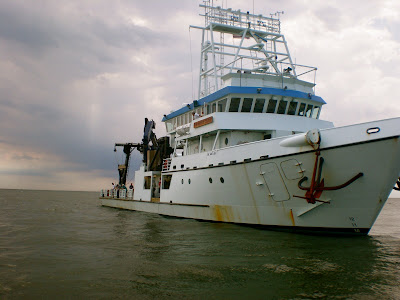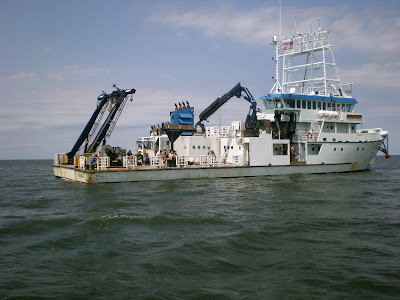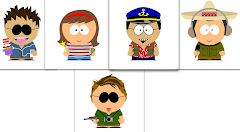Lots of great resources like OneGeology, Google Earth, and gigapan.
Monday, October 19, 2009
GSA 2009 Portland Oregon
GSA 2009 is taking place in Portland, Oregon this week, and I have been lucky enough to attend. Some very useful talks have been in the session "From Virtual Globes to Geoblogs: Digital Innovations in Geoscience Research, Education, and Outreach." Presiding at the meeting: Peter Selkin, Glenn Richard, John Bailey, Kyle House, Ronald Schott, and Mano Marks.
Thursday, October 1, 2009
State of Maine's Environment Report
As a part of my Environmental Policy major, I am taking part in a senior capstone research project. We will be investigating the state of Maine's environment through four focused assessments. I will be working with John Abbett on Marine and Coastal Policy.
Follow our progress here on our own blogspot blog!!
http://maineenvironment.blogspot.com/
The final report will be posted to our course webpage
State of Maine Report
Follow our progress here on our own blogspot blog!!
http://maineenvironment.blogspot.com/
The final report will be posted to our course webpage
State of Maine Report
Friday, August 28, 2009
COOT COOT COOT!!!
I've been back at Colby now for the past few nights for COOT2 training where I will be taking ten new froshies into the woods for a few nights. We'll be traveling up to Baxter State Park, about 3:30 hours away. A good mix for the van will be necessary.
Monday, July 20, 2009
Famous?
A link to an article in the UDaily, the University's newsletter.
Tuesday, July 14, 2009
The R/V Donna M
Another day of AUV/ROV operations. This time aboard the Donna M.
Dr. Doug Levin operated the ROV, in search of sponge communities.

I was assigned to work with the ROV as tether maintenance crew.


Monday, July 13, 2009
TIDE Goes Aboard The R/V Sharp
On Monday, the 13th, I was able to join the TIDE program on the R/V Sharp, the University's research vessel.




We conducted an AUV mission, ROV operations, dredges, and a Conductivity Temperature Depth (CTD) scan. The voyage was to the New Jersey side of Delaware Bay. The day was a success in many ways.
Sunday, July 5, 2009
A Happy Independence Day
Last night I went out with a few of the interns to see the fireworks in Lewes, and got more of an experience than I was expecting. All up and down the Bay the towns were setting off their fireworks, and with the open view, we could see them all. The night sky was lit up with the fireworks as far north as Slaughter Beach and across the Bay on New Jersey's Cape May. It truly felt like we were celebrating our Independence together as a town, state, country. Some time I may come back and watch from the bay on my future yacht.














Thursday, July 2, 2009
Composite Plot of Mendum's Pond Missions
Complements of Dr. Trembanis, here we have two composite plots of the missions we ran in June at Mendum's Pond.
"This composite plot shows all the tracklines that we ran with the AUV at Mendum's Pond. >35 km of trackline over 3 days. These plots are color coded for total depth (altitude + pressure depth). Hot colors are deeper and cool colors are shallow. More than 63,000 points are in this scene. The second image shows a zoom in on the central basin in the lake."


Tuesday, June 30, 2009
Arena's Trivia Night
Another Monday, another Arena's trivia night with cheesy fries, nachos, and $5 pitchers of Miller Lite. Team "Yoga Masters," named for our brilliance at Wii Fit Yoga, had a slight disadvantage being the youngest team collectively, missing a few dated questions. We made a good run, however, and managed a 6th out of 12. We'll be back next week.
Thursday, June 25, 2009
Learning MatLab and Being a Beach Bum
Adam came down today to discuss the basics of MatLab with me as well as go over the key aspects of the journal papers he assigned for me to read.
Then, I left from work for the day to go boogy-boarding near the bath house at Cape Henlopen. Made an awesome drip castle as well as played some paddle ball. Dolphins were swimming there again. I also started reading Arctic Drift by Clive Cussler.
After we were done at the beach at about 6, a group of us heard about some others going surfing. So, I came back to borrow a surfboard from Chelsie to go back to Herring Point in order to go surfing. Surfed for 2+ hours getting wrecked multiple times leading to a sore neck and a dizzy head. But what a great time to end the evening. Didn't leave until 9 o clock dark.
Owed Kendra dinner from a bet, so we broiled some rib-eye steaks and had rice and asparagus. Also had a glass of red chianti wine so that I can extend my life. Chocolate ice cream with jimmies and chocolate syrup for dessert. Then just chilling listing to Erick play guitar before bed.
Cape Henlopen Field Trip

We spent the remaining part of my day on a field trip to Cape Henlopen. Cape Henlopen, first settled by the Dutch, was the site of Fort Miles during WWII, when observation towers were built to monitor the coastal waterway and triangulate ship positions for any needed artillery fire. The State began a piecemeal purchasing project from the military until finally acquiring the entire block of land. The park now has bath houses, a fishing pier, and a weave of biking and hiking trails.
GEOLOGICALLY, there are some interesting things going on at Cape Henlopen. Cape Henlopen itself is a migrating spit. As you can see from the map above, there is a tip (spit) pointing out towards open water. The water on the right hand side of the map is coming from the ocean, while on the left and top is Delaware Bay. Waves coming from the ocean primarily run in the direction from the bottom right hand corner to the tip of the spit. Sediment that is picked up in the water through beach erosion is pushed along the shore in a longshore drift fashion, and when it meets the calmer water of the bay the sediment is deposited on the tip of the spit. Over time, the spit has migrated further and further into the bay.
From this image, you can see the suspended sand in the water being carried alongshore.

Now to some photos I took from the field trip. Saw dolphins just off the beach, stratified beach sand, and seined along the fish pier to collect little fishes. Also saw a massive group of horseshoe crabs mating.
Here is one of the Observation towers. It has been reworked to allow people to climb the 128 stairs to the top.
The park is open to campers, and from the top of the observation tower you can see that some have left their mark...the alien is pretty cool (made from a pile of pine needles).

In the distance is another one of the observation towers, as well as a lighthouse


In the distance is another one of the observation towers, as well as a lighthouse

There are still remnants of the military's presence. This is a bunker recessed into a section of the Great Dune. The Great Dune is a geologic feature that has been created due to wind blown sand collecting onshore. The Dune runs parallel to the Delaware Bay, so it is linked to that system. If it were running parallel to the Atlantic, it would be related to the Atlantic.


Here, we are doing a beach profile. One observer sights along a standardized pole towards the horizon. Where the observer sees the horizon intersect the pole in the foreground gives a reading as to the pole's relative height to the observer. In this photo, you can see that the observer is higher than the foreground, so the markings on the pole would read a negative number. Same concept as surveying. Profiles taken of the same area over time can show the dynamically changing beach environment.
You can see Kendra laying down the pole. We used the height of the pole as the distance between each beach profile reading, so she isn't being lazy, but moving to the next spot for the profile.


Some dolphins decided to join us while we played on the beach
Here, we are digging a shallow trench in order to see the layering of the beach's sand.

You can see how each layer is distinct in it's thickness as well as grain size. Each time deposition occurs, there are somewhat different conditions, altering the characteristics of the available sediment for deposition. More powerful conditions will coincide with larger grains.


You can see how each layer is distinct in it's thickness as well as grain size. Each time deposition occurs, there are somewhat different conditions, altering the characteristics of the available sediment for deposition. More powerful conditions will coincide with larger grains.

For the last activity, we seined for aquatic life. It involves walking with this net in a loop to close around any life in the path of the net.


Wednesday, June 24, 2009
Redeployment of Nicole's Frame: Part 2. Sunrise
"We attack at first light."
The morning greeted me at 4:45, with departure from Daiber at 5:10. We made it to Broadkill beach by 5:30, driving through the swamp marsh into a beautiful sunrise. Amazing to get the sunset and sunrise consecutively in the same place.
The "morning swim" called and we deployed the frame just inside the reef, securing it with ~4' pieces of re-bar pushed into the bed. Much easier at low tide.
Also, looking forward to the field trip planned for today to Cape Henolpen (will take many photos I expect).
Posted from my lab at Cannon 121.
Tuesday, June 23, 2009
Redeployment of Nicole's Frame - Part 1: The Phantom Ray
After a two-week deployment, it was time to retrieve Nicole's frame from Broadkill. Of course, nothing is without a hiccup - or a few:
1)The data was being transferred over an excessively long cable - dramatically increasing the time needed to complete the download. Therefore, we decided to transfer direct from the SD Card.
2)The Nortek rotary beam was taking such large data files that it filled the SD Card within 8 days of the 14 day deployment. Consequently, for the next deployment, we reprogrammed the rotary beam to collect data half as often as the first deployment (once an hour, rather than twice). This should keep enough space to gather data from the entire two week deployment.
2)The data logger being used to transfer the SD Card data crashed. Therefore, we replaced our Nikon's SD card with the one from the frame; plugged the camera into the laptop; and transferred the data through the camera. Lesson learned? Think on your feet.
3)The laptop used for programming the instruments was running low on battery, so we had to start transferring to another computer.
4)The length of time it took to collect the data and ready the frame for deployment caused low tide to pass and high tide to arrive. We attempted to deploy the frame, but the reef was too far submerged to reach.
5)A phantom ray ("unfamiliar dorsal features") threatened to eat Nicole.
The sunset was beautiful! And, even with the hurdles thoughout the day, life could be worse.
With the darkness closing in, we decided to regroup and go at it again during low tide in the AM. Of course, the plan was spur of the moment and led to a great dinner of BBQ chicken grilled over charcoal, cooked marshmellows, and Adam sleeping in a hammock. We were all serenaded to sleep by Erick Geiger. Also, Kendra and I made up some hemp bracelets. Not a bad night, in all.
Monday, June 22, 2009
Volleyball by the Sunset
Subscribe to:
Posts (Atom)























